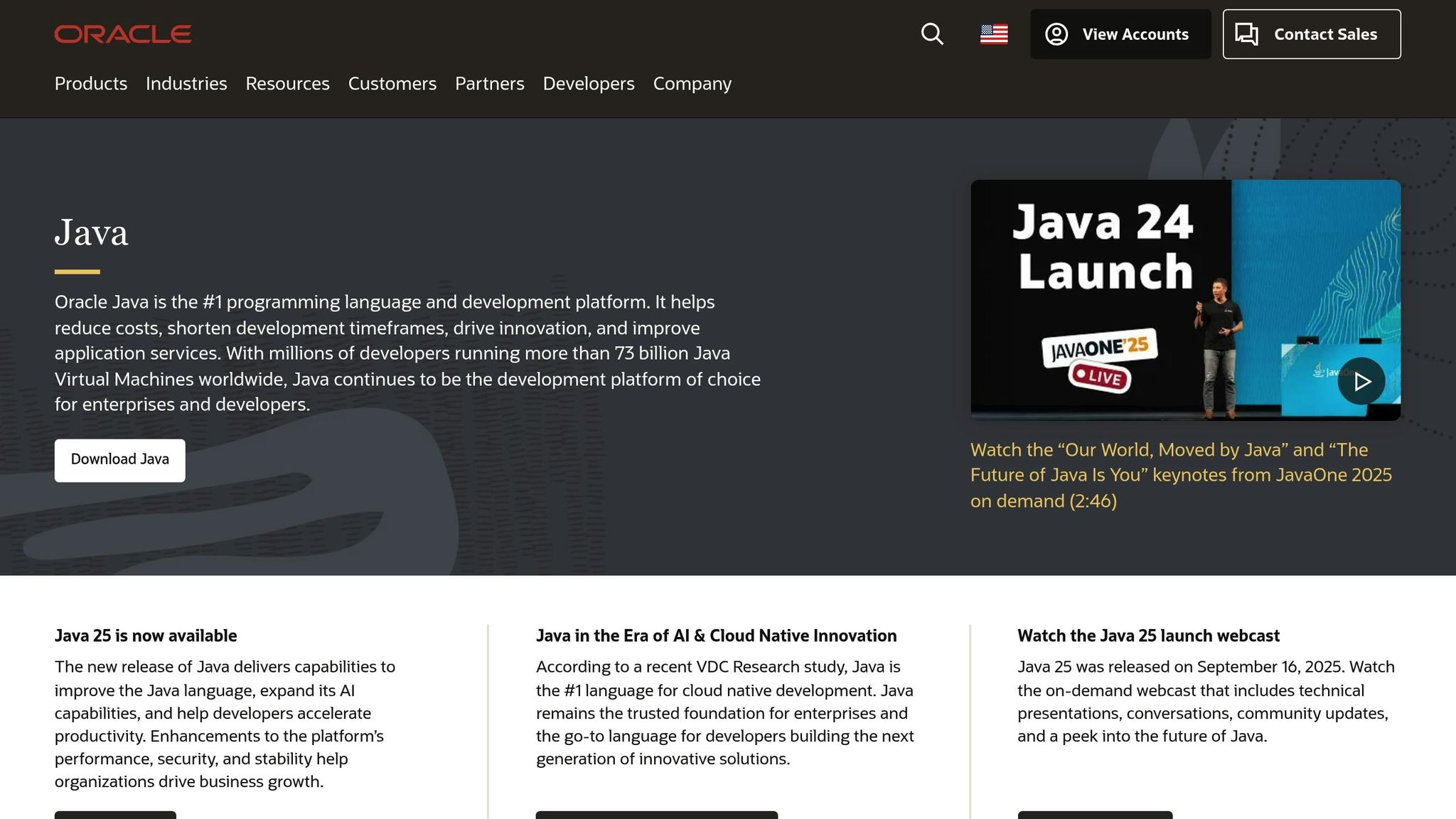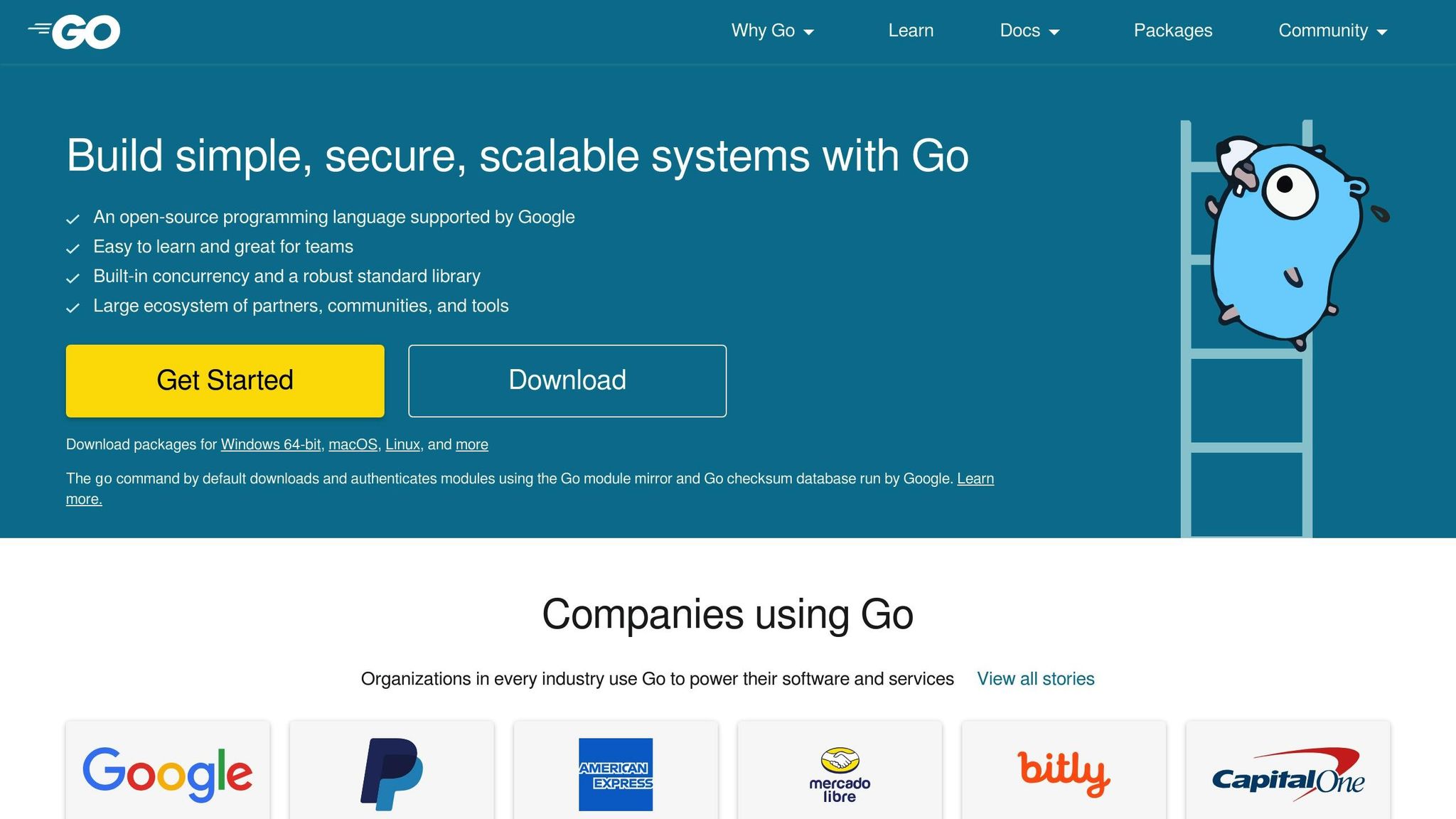


Explore the top programming languages of 2025, their strengths, and how they shape the tech landscape, from enterprise applications to cloud development.
The programming world in 2025 is shaped by evolving trends, with Python, Java, and JavaScript leading the pack. These languages dominate due to their versatility, strong ecosystems, and wide adoption in various industries. Meanwhile, Go is gaining traction in cloud-native development, and SQL remains essential for data management. Here's a quick look at the top languages and their strengths:
- Python: Simplified syntax, widely used in data science, machine learning, and web development.
- Java: Enterprise favorite for its scalability and stability, with continued relevance in backend systems and Android development.
- JavaScript: Essential for web development, with frameworks like React and Node.js supporting full-stack applications.
- C++: Chosen for high-performance tasks like gaming and system programming.
- C#: Popular for enterprise apps and game development, especially with Unity.
- Go: Rising in cloud infrastructure due to its simplicity and performance.
- SQL: Core tool for database management and analytics.
- PHP: Still a key player in web development, especially for maintaining legacy systems.
These languages are shaping the tech landscape, offering developers a variety of tools to meet modern challenges. Whether you're focused on AI, cloud infrastructure, or enterprise systems, aligning your skills with these languages is crucial.
10 Fastest-Growing Programming Languages You Must Learn in 2025
1. Python

Python's simple and flexible syntax continues to make it a favorite among developers in 2025.
Its popularity is fueled by strong demand across industries and a rich ecosystem of libraries that excel in areas like web development, data analysis, and machine learning. Python's thriving community plays a key role, contributing to open-source projects, creating collaborative tools, and supporting its use in education. These factors ensure Python remains a go-to language and a standard by which others are often compared.
2. Java

Java continues to hold a top spot in enterprise development, even with its decades-long history. Its "write once, run anywhere" approach makes it a go-to choice for powering critical systems in large corporations, offering dependable and scalable solutions for businesses.
The strong demand for Java in enterprise environments keeps it relevant. Its robust architecture, reliable memory management, and extensive ecosystem of tools make it ideal for building large-scale applications. For instance, companies like Netflix use Java heavily for their backend systems, which handle millions of simultaneous users and process vast amounts of data efficiently.
Java's developer community is one of the largest in the world. It consistently ranks among the top three most-used programming languages in surveys, with countless professionals building their careers around it. This extensive talent pool makes it easier for businesses to find skilled developers and maintain their Java-based systems. The active community also ensures that Java remains well-supported, meeting the ongoing needs of companies across industries.
Corporate demand for Java developers remains steady in sectors like finance, healthcare, telecommunications, and retail. These industries rely on Java for mission-critical applications due to its stability and maturity, making it a trusted choice for enterprise-grade software.
Java's evolution hasn't slowed down. Recent updates have introduced features like pattern matching, records, and better garbage collection, all aimed at improving the developer experience without compromising performance. The move to a six-month release cycle has also sped up the delivery of new features while maintaining backward compatibility, ensuring Java stays modern and efficient.
The Spring Framework plays a crucial role in keeping Java competitive. Tools like Spring Boot simplify application development, while Spring Cloud caters to the needs of microservices architectures. These frameworks help Java remain a strong contender in cloud-native development, even as it competes with newer languages tailored for distributed systems.
Java also benefits significantly from the Android ecosystem. Millions of Android apps still rely on Java, creating a steady demand for developers who are proficient in both Java and Android development frameworks. This connection ensures Java's ongoing relevance in mobile development as well.
3. JavaScript

JavaScript rules the web development world. Pretty much every modern website depends on JavaScript to deliver interactive and engaging user experiences, making it a must-know language for anyone working on web projects.
But JavaScript isn't just about the frontend. With Node.js, developers can use JavaScript for both client-side and server-side programming, simplifying the process of building full-stack applications. This unified approach not only reduces the learning curve but also speeds up development. On top of that, the language boasts a massive package ecosystem to support almost any functionality.
Speaking of its ecosystem, npm now hosts over 2 million packages. Whether you're looking for tools to handle data visualization or even machine learning, chances are, there's already a library for it.
Frameworks like React, Vue.js, and Angular have solidified JavaScript's role in enterprise development. Companies of all sizes rely on these frameworks to create scalable and efficient web applications. For instance, React - built by Meta - powers major platforms like Facebook, Instagram, Airbnb, and even Netflix's user interfaces.
This widespread use translates to one thing: JavaScript developers are in high demand. From startups launching their first websites to Fortune 500 companies revamping their digital platforms, JavaScript skills consistently rank among the most sought-after in job postings.
The language itself keeps evolving. Annual ECMAScript updates introduce features like async/await, modules, and optional chaining, ensuring JavaScript remains modern and efficient. Thanks to the TC39 committee's structured updates, these improvements maintain backward compatibility, so developers can adopt new features without breaking existing code.
And then there's TypeScript, which enhances JavaScript's capabilities for enterprise-level development. By adding static typing, TypeScript makes it easier to manage large codebases and catch errors early in development. Companies like Microsoft, Slack, and Shopify have embraced TypeScript for their mission-critical applications, showing how well it complements JavaScript in scaling complex projects.
Beyond the web, JavaScript now powers mobile development through frameworks like React Native and Ionic. React Native lets developers create native mobile apps using JavaScript, while Ionic supports cross-platform development. Tools like Electron even extend JavaScript's reach to desktop applications, making it one of the most versatile programming languages around.
4. C++
While many modern applications rely on higher-level programming languages, C++ holds its ground when performance and control are non-negotiable. It's a go-to choice for high-performance computing and systems programming, offering unmatched low-level hardware access and precise memory management. When raw speed is the priority, C++ consistently delivers.
Its ability to provide direct control over memory and system resources makes it a critical tool in performance-intensive applications. In today's diverse programming world, C++ stands out in scenarios where every millisecond truly matters.
Take game development, for example. C++ is the backbone of many advanced game engines. Its efficiency allows for rendering complex 3D graphics and handling real-time physics calculations - tasks that are challenging for interpreted languages to manage with the same level of speed and precision.
Beyond gaming, C++ thrives in industries like finance and embedded systems. Financial platforms depend on its rapid processing capabilities to handle latency-sensitive tasks, while embedded systems leverage its ability to maximize performance in resource-constrained environments.
The language itself continues to evolve. The C++20 standard, for instance, introduced features like concepts, modules, and coroutines. These additions not only improve code readability but also help developers avoid common errors - all without compromising the performance C++ is known for.
Major tech companies rely heavily on C++ for their core infrastructure, taking advantage of its ability to efficiently manage complex operations. Its relevance is further underscored by its active and dedicated developer community. Surveys frequently rank C++ as a top choice for system-level and enterprise development.
Recent advancements in tooling and package management have also addressed some of the traditional pain points associated with C++ development. Dependency management and build processes have become more streamlined, making the language more accessible to developers.
C++'s strengths in performance and precision set it apart from other programming languages, providing a strong foundation for the comparisons explored in the next section.
5. C#
C# has come a long way, transforming from a Windows-only language to a true cross-platform powerhouse. Its rise can be attributed to Microsoft's push toward open-source development, making it a go-to choice for modern applications like web services and cloud-native solutions. This shift has cemented C# as a key player in versatile application development.
In the enterprise world, C# continues to thrive. It's a trusted option for building large-scale business applications, particularly robust web APIs, desktop software, and enterprise solutions that demand scalability and long-term support.
With .NET 5+ enabling seamless development across Windows, macOS, and Linux, C# now stands out for its cross-platform flexibility. This has allowed it to break into areas once dominated by other languages, appealing to companies aiming to unify their technology stack across diverse platforms.
ASP.NET Core adds another layer of appeal with its high performance and lightweight architecture. It's a top choice for building microservices and API-first applications, thanks to its ability to handle high-throughput scenarios efficiently.
When it comes to cloud development, C# shines even brighter. Microsoft Azure's deep integration with C# provides developers with powerful tools to create cloud-native applications. Its strong typing system and robust tooling make it ideal for managing complex cloud infrastructure, especially for large teams.
C# also boosts productivity with tools like Visual Studio, IntelliSense, and advanced debugging features. These tools save developers time and help maintain high code quality, even in massive codebases.
NuGet, with its vast collection of pre-built libraries, speeds up development cycles by letting teams focus on core business logic instead of recreating common functionalities.
Recent updates to the language - such as nullable reference types, pattern matching, and record types - enhance both safety and expressiveness without disrupting older codebases. These improvements reinforce C#'s position as a modern and reliable programming language.
sbb-itb-e54ba74
6. Go

While C# continues to expand its cross-platform capabilities, Go has carved out a strong position in powering cloud and infrastructure systems. It’s no exaggeration to say that Go has become a cornerstone of modern cloud infrastructure and enterprise systems. With over 1 million developers using Go in cloud environments, its popularity has surged. In 2024, Go ranked as the third fastest-growing language on GitHub, following Python and TypeScript. This growth stems largely from its role in backend development, cloud-native tools, and automating infrastructure. Notably, Go now accounts for 12% of all automated API calls, a jump from 8.4% the previous year.
One of Go’s standout features is its ability to compile into a single binary without runtime dependencies. This makes deployment fast and simple, especially in containerized environments. Its built-in concurrency model, featuring goroutines and channels, enables it to handle thousands of simultaneous tasks while using minimal memory per task. These capabilities have made Go a go-to choice for many major tech companies. For instance, Netflix relies on Go for backend services that process API requests and handle data. Similarly, Uber reported a staggering 99.99% reduction in latency outliers after migrating its geofence service from Node.js to Go. Clearly, Go’s performance aligns perfectly with the demands of modern, high-efficiency systems.
Go’s influence in the containerization world is undeniable. Both Kubernetes and Docker, foundational tools of the container revolution, were written in Go, cementing its central role in cloud-native development. DevOps teams also lean heavily on Go when building critical tools. For example, Terraform, HashiCorp’s infrastructure-as-code tool, is built with Go. Its robust error-handling capabilities and concurrency model make it ideal for managing distributed cloud resources reliably.
Experts in the tech industry often highlight Go’s distinct advantages. Paul Jansen, CEO of TIOBE Software, sums it up well:
What makes Go unique in the top 10 is that Go programs are fast and easy to deploy while the language is easy to learn.
Go’s appeal isn’t limited to tech giants. Financial institutions have also embraced it. American Express uses Go to build payment processing systems, while Monzo relies on it for secure microservices. Comparisons reveal that Go applications can be up to 10 times smaller than their Java counterparts, leading to faster file loading and lower memory usage. Go-based servers also handle more requests per second under high-concurrency conditions. These efficiency gains make Go an excellent choice for serverless functions and microservice architectures, where every bit of performance impacts scalability and costs. It’s no wonder Go has found a home in both tech and finance industries.
As organizations increasingly adopt microservices and infrastructure-as-code strategies, the demand for Go expertise is skyrocketing. Currently, over 1.9 million developers work on web services and business applications using Go microservices, while about 1 million developers manage internal platforms and DevOps pipelines with Go-based tools. Go is also gaining traction in AI infrastructure projects, with tools like LangChain Go, Firebase GenKit, and kServe showcasing its potential in production AI models. More than 40% of companies heavily using Go operate in the tech sector, including major players like Google, DataDog, HashiCorp, Apple, and Salesforce. This widespread adoption highlights Go’s ability to tackle the complex challenges of distributed systems and modern cloud computing with ease.
7. SQL
SQL continues to be a cornerstone for managing and analyzing data in today’s business landscape.
One of SQL’s biggest strengths is its consistent syntax, which provides a universal way to query and extract insights. This reliability makes it an essential tool for businesses of all sizes, from startups to global enterprises.
Another key reason for SQL’s popularity is how well it works across different database systems. Whether you’re dealing with traditional relational databases like MySQL, PostgreSQL, Microsoft SQL Server, or Oracle Database - or using modern cloud-based solutions - SQL’s core syntax stays mostly the same. This consistency means developers can easily apply their skills across multiple platforms, saving time and effort when switching tools or environments.
In recent years, SQL has grown beyond basic queries to include advanced analytical capabilities. Features like window functions, common table expressions, and JSON handling make it powerful enough to tackle complex data analysis tasks. These enhancements allow SQL to play a vital role in fields like data science, business intelligence, and even full-stack development, where detailed data workflows are increasingly common.
The rise of cloud computing has only made SQL more important. Major cloud providers now offer scalable, SQL-compatible services that integrate seamlessly with other cloud tools. These services handle the infrastructure behind the scenes, letting users focus on their data while still working with SQL’s familiar interface.
Perhaps one of SQL’s most appealing qualities is its approachable learning curve. Its declarative syntax allows users to focus on what they want to achieve, rather than getting bogged down in how the data is retrieved. This simplicity makes SQL accessible to a wide range of professionals, both technical and non-technical, and positions it as an excellent entry point for anyone starting a career in tech.
8. PHP
PHP continues to hold its ground as a key player in web development. While it has faced its share of criticism, the language has proven its staying power in a rapidly evolving tech landscape. Its role in powering some of the world's most prominent websites underscores its importance in the ecosystem.
One of PHP's standout strengths is its extensive adoption, particularly in web development. A major reason for this is its integration with popular content management systems like WordPress, which supports a staggering number of websites globally. This widespread use provides PHP with a solid foundation to build upon as it evolves.
With the release of PHP 8 and beyond, the language has introduced features like union types, named arguments, and match expressions. These updates improve code clarity and make it easier to maintain, aligning PHP with the standards of modern programming. Moreover, enhancements like JIT (Just-In-Time) compilation have significantly boosted performance, ensuring PHP remains competitive. Its approachable learning curve and comprehensive documentation continue to attract new developers as well.
The job market for PHP developers remains stable, especially for roles involving the maintenance and upgrading of existing systems. While it may not always be the first choice for brand-new projects, there are still plenty of opportunities for those skilled in PHP.
Modern frameworks like Laravel and Symfony have also been pivotal in keeping PHP relevant. These frameworks offer practical solutions for common web development challenges, including features like dependency injection, database migrations, and tools for building robust APIs. They make PHP a more efficient and appealing choice for developers working on both legacy and modern projects.
That said, PHP does face hurdles when it comes to new projects. Many developers and organizations are leaning toward other technologies they perceive as more modern or forward-looking. This has led to PHP being more closely associated with maintaining and updating existing systems rather than spearheading new initiatives.
Despite these challenges, PHP's community remains active and engaged. Regular updates to its major frameworks and incremental improvements to the language itself ensure that PHP remains a dependable option for web development. Whether for maintaining legacy systems or tackling modern web projects, PHP continues to prove its value as a mature and reliable tool.
Language Comparison: Strengths and Weaknesses
Choosing the right programming language often comes down to understanding its pros and cons. Here's a quick look at C#:
| Language | Key Strengths | Main Weaknesses |
|---|---|---|
| C# | Excellent integration with the .NET ecosystem and Unity, making it a go-to for game development; works across multiple platforms | Facing reduced popularity as market demands shift |
C# stands out for its seamless compatibility with .NET and its stronghold in game development via Unity. However, its waning usage in certain areas highlights the need to carefully assess its long-term viability.
Balancing these strengths and weaknesses can help developers make informed choices as they navigate the tech landscape heading into 2025.
Key Takeaways for 2025
As we look ahead to 2025, Python, JavaScript, and Java continue to dominate the programming landscape, while Go is gaining traction, particularly in cloud infrastructure. These shifts offer valuable insights for developers and marketers shaping their strategies.
AI is playing a transformative role in development workflows. A striking 80% of developers now incorporate AI tools into their processes, boosting the appeal of languages that integrate seamlessly with machine learning frameworks. But there's a catch - trust in AI is still shaky. Only 29% of developers trust AI's accuracy, and a significant 66% find themselves spending extra time fixing AI-generated code that’s “almost right”. This trend highlights the growing need for languages that are optimized for AI-driven tasks.
At the same time, the concept of who qualifies as a "developer" is evolving. Thanks to AI and low-code platforms, more people without formal programming expertise are stepping into coding roles. This means tech marketers and advertisers need to rethink their approach, targeting a broader audience that goes beyond traditional software engineers.
For developers, aligning skills with emerging trends is key. Python remains a go-to for AI and data science, while JavaScript’s flexibility across web, mobile, and server-side applications keeps it a strong choice for the future. Meanwhile, Go’s increasing use in cloud infrastructure creates exciting opportunities for backend specialists to explore.
Community engagement remains a cornerstone for growth and problem-solving. Platforms like Stack Overflow (used by 84% of developers), GitHub (67%), and YouTube (61%) are the top resources developers turn to when they need a second opinion or doubt AI-generated solutions.
For marketers aiming to connect with developers, it’s not just about the tools - they need to deliver content that solves real problems. Platforms like Google Ads, GitHub, and Medium are effective channels to reach this audience.
Building and nurturing communities is another powerful strategy. Seventy percent of marketers believe community building enhances customer retention, and 82% of consumers prefer to buy from companies that foster engaging online communities. Investing in these spaces can lead to lasting benefits for brands targeting developers.
FAQs
Why is Python a top choice for data science and machine learning in 2025?
Python continues to dominate as a leading choice for data science and machine learning in 2025, thanks to its easy-to-read syntax, flexibility, and a powerful suite of libraries like NumPy, Pandas, TensorFlow, and PyTorch. These tools simplify the process of building, analyzing, and scaling AI-driven solutions, making Python a favorite among developers.
What also sets Python apart is its thriving community, which provides frequent updates, abundant learning resources, and dependable support. Its ability to adapt to various industries - whether it's healthcare, finance, or beyond - cements its role as an essential tool for tackling today’s complex technological challenges.
Why is Java still a top choice for enterprise development in 2025 despite the rise of newer programming languages?
Java continues to be a top contender for enterprise development in 2025, thanks to its well-established ecosystem, steady evolution, and ability to meet modern demands. With advancements like GraalVM and Project Loom, Java has significantly improved in performance and scalability, making it a go-to choice for microservices, cloud-native applications, and even AI-driven technologies.
Its broad adoption, extensive tooling, and active community make sure Java remains a dependable option. Companies appreciate its reliability and seamless integration with current architectures, ensuring it holds its place in enterprise development despite the emergence of newer programming languages.
Why is Go a popular choice for cloud-native development in 2025?
Go is a popular pick for cloud-native development, and it’s easy to see why. Its goroutines offer a lightweight way to handle multiple tasks at once, making concurrency efficient and resource-friendly. This is a huge advantage when working in environments where performance and scalability are key, like in containerized applications.
What also sets Go apart is its quick startup times and low resource consumption, which are perfect for modern cloud setups. Combine that with its straightforward design and a powerful standard library, and you’ve got a language that helps developers build scalable, maintainable systems with ease. It’s no wonder Go is a go-to choice for tackling large-scale data and traffic in today’s cloud infrastructure.






